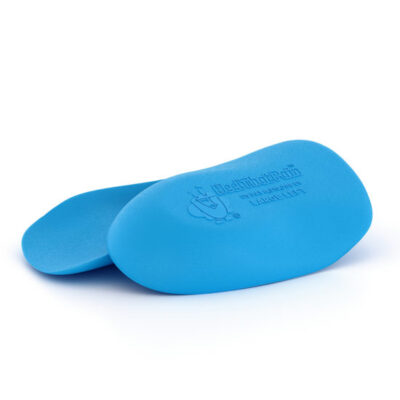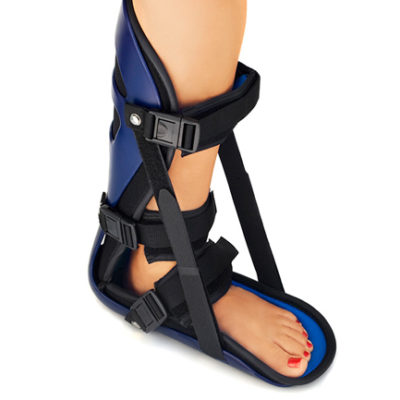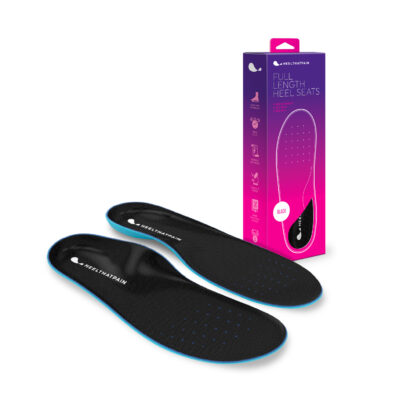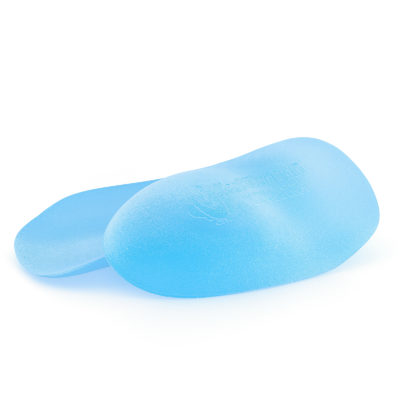Managing the pain from chronic plantar fasciitis can feel like a full-time job. And whether most of your waking hours are spent at a full-time job, at home, or on the go, it’s not always easy to make time for regular pain relief.
Thankfully, many simple yet effective treatments for instant plantar fasciitis relief can be done almost anywhere, anytime.
We’ve compiled 10 fast, effective methods that will leave your heels and arches feeling great in no time! Use them during a quick 15-minute break from work, at home while you watch TV, or even while you run errands!
1. Massage your feet
Keep a golf ball, tennis ball, or Mobility Ball in your purse, desk, or drawer at home for a cheap, effective massage tool to provide comfort and pain relief throughout the day. Use the ball while sitting at your desk, or take a quick break from standing to roll the ball beneath your foot while applying steady pressure. Don’t shy away from “hot spots” of pain. When you reach a tender area, apply steady pressure (without causing sharp or intense pain) for several seconds before you continue rolling the ball.
Pressure from this massage distracts the pain receptors of the brain, sends blood flow to the arch and heel, and breaks down painful adhesions (improperly healed tears) on the plantar fascia ligament. For extra relief, put the ball in the freezer at the beginning of the day for soothing cold therapy as well!
While larger studies showing the effectiveness of massage are somewhat scarce, you’ll find no shortage of anecdotal evidence. Several smaller studies including one published in the Journal of Acupuncture and Meridian Studies show a notable decrease in pain with self-massage (Lee & Marx, 2018).
2. Slip on an Ice Pack
Icing is a terrific way to immediately reduce heel pain from plantar fasciitis and heel spurs. A review led by Dr. Chris Bleakley, which evaluated different studies on icing as a conservative treatment for soft-tissue injuries, found that icing offered temporary pain relief and helped people return to work and sports activities faster after an injury (Bleakley et. al, 2004).
And the good news is, it doesn’t have to be a drippy, messy affair! Use inexpensive Ice Pack Slippers at work, which mold to the bottom of your foot, stay in place with soft velcro straps, and provide relief where you need it most! Ice Pack Slippers can be stored in your home or breakroom freezer and then slipped on during a 15-minute break while you rest your feet.
You can also make an easy homemade ice pack by placing a bag of frozen peas or corn in a plastic bag. Frozen vegetables make superior ice packs to the ice from your freezer, since the small particles will better conform to the contours of your foot!
3. Stretch
A study published in Foot & Ankle International found that 83% of patients were successful in using stretching to improve their plantar fasciitis pain (Wolgin et. al, 1994). There are many stretches that can be done simply and easily whenever you have a few minutes to spare. Stretching is one of the most effective ways to reduce pain and heal plantar fasciitis since it improves the flexibility, strength, and stretch of the plantar fascia ligament itself.
If you have access to a wall, a pebble, a staircase, or a belt, you can find instant relief for your heel pain as well as strengthen your plantar fascia over time! All of these stretches take just a few minutes and are simple and easy enough to memorize quickly!
4. Try Dry Cupping
Dry cupping might seem a little strange at first. It involves positioning a cup on the skin and creating a vacuum to apply negative pressure that increases blood flow to the area, which reduces pain and breaks up adhesions to the plantar fascia. Several studies show that dry cupping is effective for pain relief from plantar fasciitis (Ge et. al, 2017).
Dry cupping can be done anytime you have a few minutes to sit down, in about 10 minutes using inexpensive cupping kits. Cupping sometimes leaves red, bruise-like circles on your feet, but don’t worry — they aren’t painful, and they’ll go away after a few days.
5. Use Toe Separators
Toe separators elongate shrunken tendons that have become short and tight, gently encouraging toes to uncurl to a healthy position. Toe stretchers also improve blood flow to the feet, which breaks down adhesions, improves heel and foot pain, and strengthens muscles and ligaments in the toes and beyond.
Use Toe Separators to gently stretch and align the foot and toes anytime you are sitting or lying down (writing an email, watching TV, whenever you have 10-15 minutes!). Not only will your feet and toes be stronger afterward–they’ll feel great, too!
If you spend a lot of time on your feet, you’ll want to use orthotic inserts to cushion your feet and reduce pain while you walk. Heel Seats are inserts made specifically for plantar fasciitis and raise the foot’s arch to the optimal position to relieve pain from heel spurs, as well as targeting pressure points in the foot for rapid pain relief. The best part about this treatment is that it works while you walk or stand! No need to stop what you’re doing.
6. Use Night Splints at Night, and Orthotics During the Day
If you spend a lot of your day sitting, you can also use a Night Splint to keep your foot gently stretched and relieve pain while you send emails, read a book, watch TV, or rest on the couch. Many people with plantar fasciitis choose to tag-team orthotic inserts and night splints throughout the day and night, whenever they will be resting or standing/walking. Many podiatrists recommend these splints since consistency is one of the biggest factors in success when it comes to recovering from heel pain(White, 2009)
7. Try TENs Therapy
Transcutaneous Electrical Nerve Stimulation, or TENS therapy, is a relatively new treatment for plantar fasciitis that stimulates the nerves in the feet with small doses of electrical current to improve blood flow and interrupt the body’s signals for pain. Some TENS devices look like a pair of sandals that you can slip onto your feet beneath your desk at work, while you sit on the couch at home, or even while you are lying in bed first thing in the morning. Other TENS units look like small cellphones, with attached electrodes that can be placed on different parts of the foot.
Emerging evidence, including a study published in 2017 in the Journal of Physical Therapy Science shows that TENS therapy significantly helps reduce inflammation, reduces stiffness and pain to the plantar fascia, and reduces pain while walking and other activities (Ge et. al, 2017).
8. Strengthen Your Feet With a Washcloth
In one study, patients who were receiving shockwave therapy for plantar fasciitis were split into two groups: those who added simple plantar stretches to their routine, and those who did not. At the end of eight weeks, the patients who stretched were much more satisfied with their overall treatment experience (ScienceDaily, 2010).
One of the easiest ways to stretch your feet is with a simple washcloth. You can bring this washcloth with you to work, or keep one on your nightstand at home for a simple, fast pain-relief method any time! Simply sit on a chair or your bed, and put the washcloth on the floor in front of your feet. Then, using only your toes, attempt to pull the washcloth underneath your feet. Watch this video to see the process:
This deceptively simple exercise strengthens and builds weak muscles in the feet that contribute to plantar fasciitis. Make sure you do this stretch with both feet, not just one!
9. Roll Your Feet with a Water Bottle
Chances are, you have a water bottle at your desk at work, in your kitchen at home, or on your bedside table. With this simple remedy, you can turn into a great tool to treat plantar fasciitis.
Similar to the ball stretch, simply sit in a chair and roll the water bottle between the heel and ball of your foot ten times, then switch sides. Apply steady pressure, but never to the point of pain. For extra healing and relief, freeze it beforehand!
Watch this video to see how it’s done:
10. Stretch Your Feet With a Book
Have a thick book lying around (a dictionary, or the employee handbook, perhaps?). You have a fantastic tool for treating plantar fasciitis! Use this technique during a break at work, or make a habit of doing this stretch each morning before you head out the door. The book stretch offers quick pain relief for plantar fasciitis and also strengthens the ligaments and muscles in your feet!
Place the book about two feet away from a wall. Then, stand on top with your heels hanging off the back edge. Slowly lean forward with your hands in front of you until your weight is supported against the wall in front of you. Hold this pose for 15 seconds, straighten your back, and lift your feet up and down using the balls of your feet. Next, do this stretch with one foot–then switch sides!
Products guaranteed to help plantar fasciitis within 30 days
If you’re sick of waiting around for your feet to feel better, you’ll love these products. Each are backed by a money-back guarantee, with 9/10 people noticing significant improvement from heel pain within a month.
Original Heel Seats: Heel Seats were designed specifically for plantar fasciitis and other types of heel pain. They gently lift and realign the plantar fascia ligament, while also cushioning the bottom of your heel.
Full Length Heel Seats: Full Length Heel Seats contain the same patented and proven technology as Original Heel Seats, but span the full length of your shoe. They are less likely to slip or slide, making them a great option for athletes and active people.
Classic Night Splints: Night Splints are one of the top-recommended products by doctors. They gently stretch your plantar fascia ligament throughout the night so that you wake up with fresh, happy feet.
Most common questions about quickly treating plantar fasciitis
Unfortunately, most people are not able to cure their plantar fasciitis in one week. In fact, for many, it takes 6 months or longer to fully address the problem. There is also no single known cure for plantar fasciitis, but instead a wide array of options that you and your doctor can choose from depending on your exact circumstances
Again, there is no single, easy answer. Your best bet to healing plantar fasciitis quickly is to rest as much as possible from vigorous exercises and long hours of standing, wear high quality orthotic inserts, begin a daily stretching routine, and visit your podiatrist sooner rather than later.
There are many options for the short-term relief of plantar fasciitis pain. Self-massage and icing are two good options to try, and you can do them easily from home.
The good news is, 9/10 of our customers notice a significant improvement in their condition within 30 days of wearing Heel Seat orthotics. The vast majority of cases of plantar fasciitis are resolved within 6 months with conservative treatments like orthotics, resting, icing, and stretching.
Whether you spend most of your time at a desk in an office, behind a store register, or on your feet running after grandchildren at home, these quick plantar fasciitis treatment techniques are fast, easy, and adaptable to almost any situation. Keep this list handy to keep your heels and arches happy all day long!
References
- Bleakley C, McDonough S, MacAuley D. The use of ice in the treatment of acute soft-tissue injury: a systematic review of randomized controlled trials. Am J Sports Med. 2004 Jan-Feb;32(1):251-61. doi: 10.1177/0363546503260757. PMID: 14754753.
- Ge, W., Leson, C., & Vukovic, C. (2017). Dry cupping for plantar fasciitis: a randomized controlled trial. Journal of Physical Therapy Science, 29(5), 859-862. https://doi.org/10.1589/jpts.29.859
- Lee, T. L., & Marx, B. L. (2018). Noninvasive, Multimodality Approach to Treating Plantar Fasciitis: A Case Study. Journal of Acupuncture and Meridian Studies, 11(4), 162-164. https://doi.org/10.1016/j.jams.2018.04.002
- ScienceDaily. (2010, November 4). Plantar fasciitis? stretching seems to do the trick. ScienceDaily. Retrieved November 1, 2022, from https://www.sciencedaily.com/releases/2010/11/101104101657.htm
- White, J. (2009, November). Secrets To Patient Adherence With Night Splints. Podiatry Learning Network. Retrieved November 1, 2022, from https://www.hmpgloballearningnetwork.com/site/podiatry/secrets-to-patient-adherence-with-night-splints
- Wolgin M, Cook C, Graham C, Mauldin D. Conservative treatment of plantar heel pain: long-term follow-up. Foot Ankle Int. 1994 Mar;15(3):97-102. doi: 10.1177/107110079401500303. PMID: 7951946.





Ice Pack is really a great way reduce heel pain.. Thank you for sharing this helpful list. 🙂
Pain in the heel of both the toes.
Also a symptom of an under active thyroid gland(hypothyroid) take iodine supplements along with selenium. If this is you….it works within days…
Thyroid issues are related to planters? I have both and never made the connection. Thank you.
Hi I have chronic foot pain I’m also having other symptoms ie exhausted,itching, the list goes on, I’m wondering if I may also have an under active thyroid. Would the selenium and iodine help ?
I have plantar fasciitis. I have had it fir 10 weeks and it is not getting better.
That is awesome to know! The doctors haven’t told me all that! I have hashimotos and literally cry and have to crawl to the bathroom in the mornings on a daily with my feet.
OMG!! 2 days ago I could barely walk and I had severe back pain, also my whole body was outta whack.
The pain was so bad that I did what you suggested, thyroid supplement with iodine. The pain is gone in my foot thank God but I still have back pains. The thing is I don’t even know if I have an underactive thyroid but I just needed something for the pain
Wearing only Birkenstocks has improved 2 years of heel pain within a month!
They are expensive but last much longer than other shoes/slippers but more importantly I can actually enjoy walking again.
Ive been using SCHOLLS also a great improvements
Rach, I also have dealt with PF for 2 years now and nothing works. I’ve heard people say to try Birkenstocks but have been apprehensive because I have already tried so many other suggested shoes. How quickly did you notice a difference and how long have you been wearing them? I know some shoes seem to help for 2-3 weeks and then I’m right back to looking for something new because they no longer help. I also wonder which style to get.
I have suffered Pf for years on and off. I can only wear FitFlops, as they are the only shoes/boots/sandals that help. I will be trying a new exercise regime as my PF is really painful at present.
Birkenstock give me the pain when I wear them for a long time
Years ago when I was teaching, I suffered greatly with PF. Luckily I could use Birkenstocks. I felt great relief within a few days of using them. One of the key things is to have your feet measured so you get the right type. I also used to use the foot taping method with stretches and that is how I eventually managed the pain.
I had PF and both Skechers Go Walk shoes and help me a lot. I could not walk wearing any other shoes so with Skechers I was again active.
I own several pairs of birkenstocks, they do help. I also use their inserts in my sneekers, at a fraction of the cost, that may be an option to try before investing in a sandal or shoe.
Unfortunately, I have not found that wearing g Birkenstock sandals has helped my plantar fasciitis at all. I am glad to see that they help some people though !
Can you please let me know of which birkenstocks did you use? I am really suffering from planter pain.
Many thanks.
Sukhi
I had a hip replacement 8 weeks ago, and I’ve developed PF (for the second time). I just replaced my old tennis shoes, so hopefully that will help. I think the hip replacement has to do with the PF. Has anyone ever heard of this?
Mary,I had a THR a year ago and am now dealing with excruciating pf on my non surgical foot.
Mary, the same thing happened to me. I had a left THR in December of 2017. The last 3 months I developed PF. Burning sensation in my arch. Painful to walk on it. Opposite leg of the THR. Very annoying. Going to try these techniques and their shoe insert. Good luck!
I’ve only suffered from this for 3 weeks but it is getting worse! I played badminton 3 times a week now I’m struggling to walk!!! Help before I get fat!!!
Acupuncturist will take pain away ASAP
I had an excruciating flare-up of PF for 2 weeks and NOTHING was helping. I’ve gotten relief for upper back pain with pressure points therapy (self administered) and wondered if there were pressure points for PF. Yesterday, I easily found the answer on the internet and immediately went to work on 2 points in my calf. They were easy to find because they were sore. Today, my PF is completely gone.
Where are the pressure points – I am suffering terribly with this pain
There are pressure points in various places in your calves and foot. Check You Tube. There are videos about where they are an how to use pressure to release them.
Where are these pressure points I’m very desperate.
Can you provide points and or website where you found these details? Thanks
I’ve recently began to suffer with ps, it flares up after running I have just bought some new running trainers with arch support but I was hoping to try them when the ps pain has completely gone. Does it ever go away or will the pain be there forever now? There are so many remedies I feel overwhelmed with what to try!
Has anyone tried steroid injection? Any side effect? I have PF for a year, tried everything and rather desperate now.
Yes I have tried them and they really work. Go to a sports medicine doctor, they are great!
Had shots in each heel. Worked for about a month. Suffered for 8 months and then I was In a discussion forum (Marks’s Daily Apple). I cut out sugar and my pain level went from a 9 to a 2 in a week! After two weeks, pain was gone…..that was 4 years ago and haven’t suffered since. If I eat way too much sugar my feet get sensitive again and I just cut back.
I tried shots, boot, custom soles and anti inflammatories and nothing worked but alleviating sugar from my diet. Good luck!
Had one about a year ago and it worked. Now just this past two weeks, it has flared up with a vengeance. Only had it in foot, now it’s both. Tried therapy and I don’t think it helped, that’s why I did the shot. Wish there was a better treatment. Yes they hurt, but it’s only temporary.
Thank you for sharing this Lee. I’ve been suffering from heel pain and swelling for weeks and I wondered if I should cut back on sugar. It worked for you and hopefully it will work for me too. Thank you again 😊
I’ve had several kinds of shots. No help
It hurts!
I ended up in hospital with blood clots on my lungs. After i came out this PF started in both feet! At first it felt like i was walking over rocks in my bare feet even when i had shoes on. now i have it in just my right foot, but it just won.t go! Now the pain is all round my ankle and the top of my foot,and no pain on the bottom at all.I’ve tried different excersises and support socks but nothing is working..
I also have this severe foot pain, especially when l wake up in the morning
I also have pf. I am currently in a day boot and a night boot. Plus exercise and stretching. Cortisone shot in 3 weeks if no improvement and boy do I dread that! I’m sure they hurt I can only imagine in my heel. Ughhh Doctor said Hoka shoes are the best for PF. I’ve worn those for a while surely there has to be a shoe or Insert that will help with this. Going to try the sugar advice. Does t hurt to try & it sure will not hurt me cutting back on sugar. I love my Dr pepper but….gotta do what ya gotta do I guess. Hope everyone gets their PF under control. Thank you all for the advice.